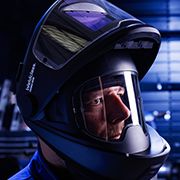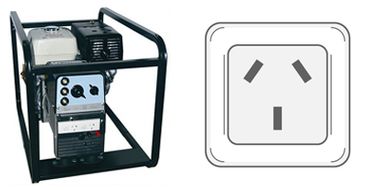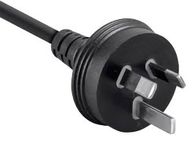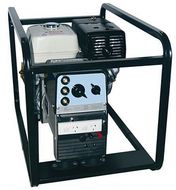Using Generators to power Inverter Welders - your questions answered

Can I use my welder on a generator? What size generator do I need to run an inverter welder?
We answer all these questions and more! Here's what we cover in this article;
- Generator power vs mains power
- Why is generator power potentially harmful?
- Why are inverter welders vulnerable?
- Input voltage protection
- Guidelines for generator use with inverter welders
- Can I use a small(er) generator to run my welder?
- Tips for purchasing a suitable generator
More Welding Machine Articles Weldclass Machine Range WIN a Weldclass T-Shirt!
1. Generator power vs mains power
Compared to mains power, generator power can be characteristically ‘dirty’ and thus has the potential to damage sensitive electronic components inside inverter welding machines. This is especially the case with smaller generator sets that are often chosen for operating the likes of power tools and welders, due to their portability and affordability.
At the same time, the ability to use generator power offers many advantages to operators wanting to run their inverter welding machines in the field or on-site where it is impossible or difficult to access mains power.
So it's no surprise that one of the first questions operators ask before they consider purchasing an inverter welding machine is: “is it safe to run off a generator?”. The truthful answer is not always a "yes". Sure, plug virtually any inverter welder into a generator and it will likely operate to some level. But not all machines have the protection required to avoid damage from ‘dirty’ or unpredictable generator power supply in the long term.
2. Why is generator power potentially harmful ?
AC (mains) power supply follows a pattern called a sine wave. When it comes to running equipment with sensitive electronics (like inverter machines and computers) power supply with a perfectly clean sine wave is the safest, however in reality this is almost impossible to achieve.
A perfectly ‘clean’ 240V single phase AC sine wave would look something like this:
Mains power is (usually) relatively close to perfect sine power and therefore it rarely poses any problems.
On the other hand, power supply from a portable generator is, by comparison, typically ‘dirty’. The peaks, troughs and cycle frequency will not be consistent even though the average output power may still read 240V on a simple measuring device like a multimeter. Generator power can also be characterised by voltage ‘surges’ (a rise in voltage) and voltage ‘spikes’ (very sudden peaks of excessive voltage).
In a generator, voltage surges and spikes can occur due to a number of reasons, including:
- Generator Quality: All portable generators typically produce inconsistent power when compared to perfect sine wave power. This degree of variation from perfect sine wave power is measured as a percentage called ‘Total Harmonic Distortion’ or THD. An acceptable THD rating in a portable generator is generally considered to be 6% or less. In recent years the market has faced a lot of imports of cheap, poor quality generators with unacceptably high THD ratings (over 6%). While these cheaper generators may ran basic power tools without a problem, they are not suitable for running inverter-based machines because the voltage is likely to fluctuate and spike at an unacceptably severe level.
- Start up and Shut down: When starting and stopping a generator the engine is obviously not running smoothly and at a constant speed and therefore the output of the generator is very likely to fluctuate with engine speed.
- Fuel supply interruption: Like start up and shut down, if the generator runs out of fuel, or if there is a ‘hiccup’ in the fuel supply, the engine will typically speed up and slow down very spasmodically, again causing power fluctuations.
- Loading vs. Generator size: A generator that is under-sized &/or over-loaded will work very hard to try and maintain sufficient current supply. Then when the load is removed (eg when welding stops), the engine will typically over-rev until the governor returns the engine to idle speed. This over-revving the generator will very likely increase the voltage output, sometimes to a dangerous level.
- Additional loads: The use of other devices (eg; grinder, cut-off saw, etc) on the same generator and at the same time as the welding machine can cause overloading, and therefore cause power fluctuations, if the generator size is not sufficient.
- Lack of maintenance: A poorly maintained generator will behave in the same way that a poor quality generator does.
3. Why are inverter welders vulnerable ?
In order to significantly reduce the size of the transformer and achieve the many advantages that the inverter gives us (reduced size/weight, etc), the input power must be ‘treated’ before it enters the transformer - in other words instead of immediately passing through the transformer, it first passes through sensitive electronic components.
The main components of concern are capacitors. Capacitors are devices which constantly charge and discharge voltages. In an inverter welder, the capacitors will charge at approximately 1.4 times the standard input voltage. So in the case of 240V power supply they will charge at about 335V. The same will occur in the case of a voltage surge or spike. So for a 280V surge, they would charge at about 395V which is a voltage increase of 155V. It is this significant fluctuation in working voltage that can damage or destroy electronic components in an inverter welding machine.
4. Input voltage protection - Superior technology from Weldclass
At Weldclass, we recognise that many operators (especially in rural, construction and maintenance industries) have the need to run their welder off a generator.
Weldclass welding machines and plasma cutters are specifically developed with generator use in mind and have a high level of protection against voltage fluctuations. For peace of mind, the Weldclass warranty includes/covers the use of Weldclass machines with generator power supply (providing that the operator complies with the guidelines included in the instruction manual - see point 5 below).
The following features have been incorporated into Weldclass inverter welders to ensure optimum protection from power supply fluctuations:
- Voltage Sensing Device: This device monitors the input voltage of the machine and if the voltage rises above (or below) a certain level the machine automatically shuts off the voltage supply to vulnerable components. These high and low parameters on the Weldclass machines are set at 240V +/- 10-15%.
- High Voltage Capacitors: Weldclass inverters incorporate high performance capacitors which give the machines a higher tolerance against input voltage fluctuations and reduce the risk of damage to the capacitor and other components.
- IGBT Technology: Weldclass inverters use only the latest IGBT inverter technology, as opposed to the more traditional MOSFET technology. IGBTs are less vulnerable to mains and generator power fluctuations.
- Over Specified Componentry & Stress Tested to 440V: Key components in Weldclass machines are over-specified for guaranteed reliability, and each machine is rigorously tested during manufacture, under 440V 'overload'.
- PFC Technology: In addition, some Weldclass machine models (including 205MST, 255MST, 290MST, MIG/Stick/TIG machines & 45P Plasma Cutter are fitted with PFC (or power factor correction) technology. Put simply, PFC automatically compensates for any fluctions in input voltage, to deliver a very consistent and 'clean' power to the inverter. This greatly reduces the risk of damage from dirty power. It also significantly increases efficiency, allowing these machines to offer a higher output and duty cycle.
Because of this, when Weldclass inverters are used with generators the risk of damage from dirty power is greatly minimised.
5. Guidelines for generator use with inverter welders:
By following these guidelines the operator will minimise the risk of damaging voltage spikes, and help the welding machine to perform to its full capacity.
a. Generator Size:
Determining the exact generator size required to safely run a welding machine is not always a straightforward process. Some of the factors to be considered are: the current draw ratings of the welder, the rated output of the generator and whether this is a genuine rating (unfortunately some generators are over-rated), whether the generator will or will not be used to run other power equipment at the same time, etc.
For recommended generator sizes to run specific Weldclass machines, refer to the instruction manual or product information on this website.
Following is a Suggested minimum generator size 'rule of thumb' guide1;
|
Inverter Machine Type |
Max. Output |
Suggested "Minimum" |
Suggested "Ideal" |
|
Welder
|
Up to 130A |
6 kva (5 kw4) |
7+ kva (5 kw4) |
|
140-160A |
7 kva (5.5 kw4) |
8+ kva (6.5 kw4) |
|
|
180–200A |
8 kva (6.5 kw4) |
10+ kva (8 kw4) |
|
|
250A |
13 kva (10.5 kw4) |
15+ kva (12 kw4) |
|
|
300A |
15 kva (12 kw4) |
20+ kva (16 kw4) |
|
| 350A | 25 kva (20 kw4) | 30 kva (24 kw4) | |
| 400A | 35 kva (28 kw4) | 40 kva (32 kw4) | |
| Plasma Cutter | 30A |
7 kva (5.5 kw4) |
8+kva (6.5 kw4) |
| 40-45A |
8 kva (6.5 kw4) |
10+kva (8 kw4) |
1: Note that if it is intended that the generator will be used to run additional equipment at the same time as the welder, the size of the generator should be increased accordingly. These figures are an approximate guide only and should not replace manufacturers recommendations.
2: 'Minimum' size is the smallest that we suggest to minimise risk of voltage spikes etc, however it may not be enough to achieve full output from the welder.
3: 'Ideal' size will further minimise risk of power supply issues and will allow a higher output from the welder.
4: Approximate equivelant kw size of inverter generators, based on generator power factor of 0.8. This may vary if generator used has different power factor, check with generator manufacturer.
See further comments on generators size under point 6 below ↓.
b. Generator Quality:
As we have already mentioned (point 2a above ↑), a good quality generator suitable for running an inverter should have a low THD (Total Harmonic Distortion) output. All reputable suppliers or manufacturers of portable generators will be able to specify what the THD ratings are on their product.
Generators with a low THD rating (6% or less) will have ‘relatively’ clean power and will thus be suitable for running inverter welders.
A generator with a high THD rating (more than 6%) is likely to be a low quality unit and should not be used to run inverter welders. See also ‘Tips on purchasing suitable generators’ - point 6 below ↓.
c. The Do’s and Don’ts of using generators with inverter welders:
- Start up & Shutdown: Always disconnect the welder’s power lead from the generator before starting or stopping the engine on the generator.
- Fuel Supply: Always ensure that the generator engine has a safe supply of fuel and that the fuel line is in good condition. The engine should not be allowed to run out of fuel while the welder is connected to the generator.
- Maintenance: Always keep the generator in good condition. Do not use a generator that is in need of service or replacement.
- Power Extension Leads: Do not use power leads that are of poor quality or in need of repair or replacement. Always use heavy duty leads - see table below.
Suggested Guide for cable size of extension leads used with Inverter Welding Machines*:
|
Welding Machine |
Power Supply |
Suggested Minimum |
|
Up to 200A |
240V 10A/15A |
Lengths up to 10m: 2.0mm2 Lengths over 10m: 2.5mm2 |
|
250A |
240V 15A |
2.5mm2 |
|
240V 20/25/32A |
4.0mm2 |
*These figures are an approximate guide only and should not replace manufacturers recommendations.
6. Can I use a small(er) generator to run my welder?
As shown in the table 5a above ↑, the recommended minimum generator size is not less than 7kva (for up to 160A welders). We often get asked questions like "why can't I use my 5kva generator to run this welder?".
We also sometimes see other welding machine suppliers suggesting that their machines can be powered by generators as small as 4-5 kva.
Sure the welder might actually operate to some level, but here's why using smaller under-sized generators is NOT a good idea;
- As explained in point 2d above, the generator will have to work much harder and this will greatly increase the liklihood of severe power spikes that could damage the welder, or cause it to frequently shut down.
- The output from the welder will be significantly reduced, possibly to the point where the machine is of little use... or becomes very frustrating to the operator.
- Often the generator will be used at some point to operate other equipment (eg power tools) at the same time and this will further compound the above problems.
Although a larger generator will cost more initially, a correctly sized (or over-sized) generator will allow you to get the job done right the first time... and greatly reduce the risk of costly damage to your welder. And who ever regrets having 'too much' performance?
Here's another way to look at it; let's say you're buying a motor vehicle to tow a trailer. Would you purchase a vehicle that only just has enough power, and has to constantly operate close to "red line" rpm to do the job? Probably not! In the same way, buying a generator that has more power/output than what you actually need makes a lot of sense.
See further comments under point 5a above ↑.
7. Tips for purchasing a generator suitable for running welding machines
Generator Quality: As we have already mentioned, a good quality generator suitable for running an inverter should have a low THD output (see 2a & 5b above ↑) of 6% or less. All reputable suppliers or manufacturers of portable generators will be able to specify what the THD ratings are on their product.
Heavy Duty / Frequent Use: If it is intend to use the generator very frequently / full time / every day (for example mobile welding operations), we strongly recommend that the user considers purchasing a generator that has a “brushed” alternator with compound regulation, or Automatic voltage regulation (AVR) technology.
While these type of generators are generally more costly than standard generators (with “brush-less” alternators), their voltage regulation & output is far superior & ‘cleaner’. This means that they are much less likely to cause power supply problems that will cause the welder to shut down or become damaged.
Got any questions?
Post a comment at the bottom of this page ↓ , or click here send us an enquiry.
More articles on inverter welders;
What is an inverter welder & how does it work?
What is duty cycle and how is it calculated?
While all care has been taken, Weldclass accepts no responsibility for any inaccuracies, errors or omissions in this information or links and attachments. Any comments, suggestions & recommendations are of a general nature only and may not apply to certain applications. It is the sole responsibility of the user and/or operator to select the appropriate product for their intended purpose and to ensure that the product selected is capable of performing correctly and safely in the intended application. E.&O.E.
-
Size of solar to run a 200amps inverter welding machineDate: 26-12-2023Emelito Magpayo Ecmconstruction -
Garin, thank you for your question. All the details in this article also apply to running plasma cutters on generators. Note the table under 5a includes some data for plasma cutters. Regarding air compressors, we suggest you check with the manufacturer of the compressor to determine the generator size needed for this, and note that if using a single generator to run both plasma cutter and compressor, the size of the generator should be increased accordingly. For example is the plasma requires 8kva and the compressor 7kva, then generator size should be 15kva to allow for running both units at the same time.Date: 22-05-2023Weldclass Weldclass -
Can i run a welding machine using solar system?> How do i size for a solar system either 1 or 3 phase system. 0720320915.Date: 19-05-2023Salesio Nyaga Glosec Systems Ltd -
Do you have any further advice about running your plasma cutters on a generator? With the required air compressor please. ThanksDate: 18-05-2023Garin -
Hello.. I have no knowledge about this and i plan to buy a generator, can i use a 50kva generator in a 300amp inverter welder,Date: 03-02-2022Romel Gorio -
What actual size or amp is suitable for 250A welder?Date: 20-10-2021Derrick Frimpong -
Thank you very much for very helpful information about the Welders and Generator. I work in the remotes part of Northern Kenya and I have a desire to start work. I am confident that the information from this article is great guide for my further endeavours. I only have one question, how could your products be shipped to me in Kenya? I will appreciate your kind response.Date: 04-07-2021Kairu Kahiga Christ Is The Answer Ministries - (CITAM) -
Ladeth, please see point 7 of this article “7. Tips for purchasing a generator suitable for running welding machines”.Date: 07-07-2020Weldclass Weldclass -
What os the suitable type of generator for welding for long hours usageDate: 06-07-2020Ladeth CGS -
Regine, we recommend that you confirm this with the manufacturer of the 300A welder. Generator size required will depend on number on the power draw requirement of the machine, which can vary depending on type of machine (inverter vs transformer), efficiency ratings, etc.Date: 15-06-2020Weldclass -
What size of generator can i use to run a 300A inverter welding machine '?Date: 15-06-2020Regine Dela Fuente -
Ross, input current varies from one brand/model of machine to another. The best comparison is the usually the effective input current draw rating (I1eff).Date: 19-05-2020Weldclass Weldclass -
what input current is drawn from a single phase 200a inverter & a 3 phase 400 amp inverterDate: 15-05-2020Ross Peters ABC ELECTRIC -
Hello, I am in America and am interested in welding. I have no experience, but plan to begin welding soon. I have a question that I haven't been able to answer, as of yet: I'm interested in getting a generator like a Champion 5.5KW dual generator. As you probably know, it's 240 VAC, two phase. I also want a 230VAC, single phase arc welder. I've seen people weld, using L14-30 to 14-30 adapter with no issue(YouTube). I think, however, using only one of two phases would create an unbalanced load and, eventually, damage the generator. What are your thoughts, sir? Thank you, William ReynoldsDate: 24-04-2020William Reynolds -
Ronald - regardless of the output setting that the welder is expected to operate at, we do not recommend using under-sized generators. As you will notice - under point 5a in this article - the difference in recommended generator size for 140A vs 180A welder is only 1kva (7kva to 8kva). Whilst the welder may operate OK on lower output etc - the fact remains that by using a under-sized generator you do increase the risk of damage to the welder.Date: 24-02-2020Weldclass -
If you run the welder at a lower power, say(a 185 amp at a 140 amp) can you use a lower powered generator safely?Date: 22-02-2020Ronald Porter -
Thank you for your question JC - No the welder will not normally pose any risk to the generator.Date: 21-02-2020Weldclass -
Can a inverter welder damage a generatorDate: 21-02-2020Jc van tomder Cme sivels








